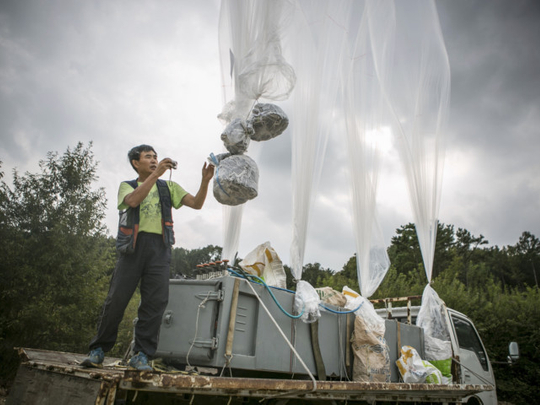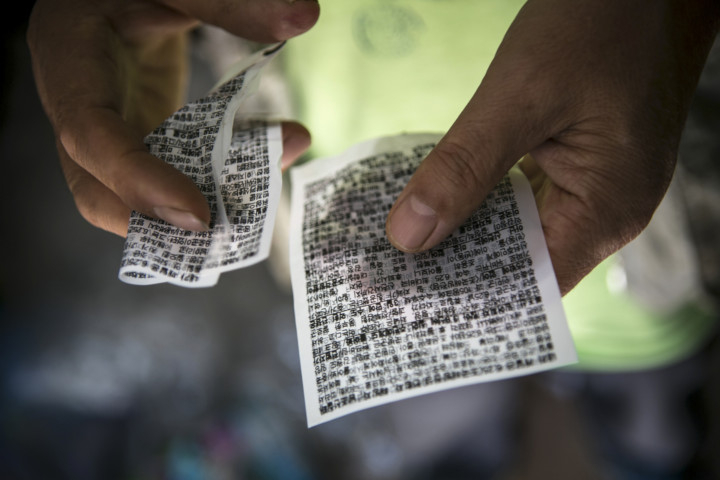
Lee Min Bok’s house, fashioned out of two shipping containers, is monitored by 12 police surveillance cameras. Dogs bark at any stranger walking up the dirt path. Plainclothes detectives check his mailbox and tag along wherever he goes to protect him from possible assassins sent by North Korea, which openly threatens to kill him.
But that has not stopped him.
On days when the wind blows to the north, Lee, 59, ventures out with his secondhand 5-tonne truck, hauling a large hydrogen tank to the border with North Korea, an hour’s drive away. There, he fills dozens of 23-foot and 39-foot barrel-shaped balloons with the gas and lets them drift away.
The balloons carry special payloads: radio sets, one-dollar bills, computer memory sticks and, above all, tens of thousands of leaflets bearing messages that Lee says will debunk the personality cult surrounding Kim Jong-un, the youthful leader of North Korea.
“My leaflets are a poison for Kim Jong-un’s regime, because they help North Koreans wake up to his lies,” Lee said during an interview at his home.
Sailing 9,800 to 16,400 feet above sea level, Lee’s balloons waft across the world’s most heavily guarded border, high enough that North Korean soldiers have little chance of shooting them down. Then his patented “timer” devices click, unfastening vinyl bundles. Leaflets fall out like snowflakes over the North, where Kim struggles to keep his people under a total information blackout, blocking the internet and prefixing all radio and TV sets to receive only his government’s propaganda-filled broadcasts.
In South Korea there are 50 “balloon warriors”, many of them defectors from the North like Lee, who seek to breach the wall with leaflets.
Lee is their godfather. When he started floating large balloons in 2005, with others following suit, he received credit — and blame — for reigniting the leaflet battle the two Korean armies had waged until it petered out with the end of the Cold War. He now launches between 700 and 1,500 balloons a year, each carrying 30,000 to 60,000 leaflets.
To anyone who will listen, Lee preaches that the best way to reform North Korea and end its nuclear weapons programme is to subvert Kim’s government from inside the country. And the surest way to do that, he says, is to infiltrate it with outside information through leaflets, radio broadcasts and DVDs filled with South Korean TV dramas and smuggled through the North’s border with China.
“Leaflets are the cheapest and safest,” Lee said. “No border guards, no radar, no radio jamming signals can stop them.”
With years of negotiations and sanctions failing to stop North Korea’s nuclear weapons programme, Washington and its allies have begun paying more attention to waging an information war. Following the North’s fourth nuclear test in January, South Korea restarted front-line loudspeakers to send blaring propaganda broadcasts across the border. Last month, Washington announced a $1.6 million (Dh5.9 million) budget for projects to “foster the free flow of information into, out of, and within” North Korea.
While some defectors claim to have fled after reading leaflets or listening to outside radio, critics say leaflets do little more than provoke Pyongyang.
It calls them an act of war and threatens to direct an artillery attack at their launching sites near the border. Balloonists have clashed with South Korean villagers worried about becoming targets of Northern retaliation.
In 2011, a man was arrested on a charge of plotting to assassinate a balloon activist at the behest of North Korea. Three years later, the North directed anti-aircraft fire into the South Korean sky, trying to down one of Lee’s balloons. This year, it began retaliating in kind, floating to the South leaflets that called President Park Geun-hye a snake and a prostitute.
Andrei Lankov, a professor at Kookmin University in Seoul who grew up in the former Soviet Union and studied at a North Korean university, was sceptical about the impact of leaflets on the North.
“One leaflet is not going to change views of a person who is exposed to daily official propaganda,” he said. “However, it would be mistake to stop the campaign now. That is what the North Korean authorities demand, and it is not a good time to show weakness.”
But Lee said his own story is proof that a leaflet can change a North Korean’s life.
He was a biologist at a state-run agricultural research institute in 1990 when he picked up a leaflet from the South while on a trip near the border. It made what was to him the shocking claim that the Korean War started in 1950 with a North Korean invasion.
In the North, he said, the government had taught people to hate the Americans by endlessly reiterating that the United States and its South Korean puppets started the war. Lee did his own research, asking old veterans and people who had lived near the border when the war started, and became convinced the leaflet was right.
By then, his faith had already been shaken, after authorities reprimanded him for suggesting agricultural reforms.
Lee fled the North in 1991 and, after travelling through China and Russia, arrived in the South in 1995. On his way, he was helped and baptised by South Korean missionaries.
Today, sending balloons is Lee’s full-time job. He finances his operation with cash he earns from lectures he gives at churches and elsewhere. Christians also donate, asking him to drop small Bibles and food into the North. A Japanese group contributes with the understanding he will send leaflets urging North Koreans to help find the whereabouts of dozens of Japanese believed to have been abducted to the North.
Lee said his obsession with leaflets made him neglect his family. The South Korean wife he married in 1996 divorced him. He is now married to a Chinese woman who is far more supportive.
“You need a partner in this work,” Lee said. “You don’t know when the right wind will blow, and your wife is the only helping hand you can get when you have to rush out with balloons.”
Toned-down provocation
Lee avoids clashes with villagers by releasing his balloons away from their towns. Unlike more flamboyant activists, he seldom invites journalists to his launchings. The other activists’ leaflets often carry highly personal attacks on Kim, ridiculing him as “a nuclear lunatic” and exhorting North Koreans to overthrow the “bloodthirsty pig”. Lee believes that a less provocative approach will yield better results.
His leaflets, for instance, list the number of cars and other figures from South Korea’s vastly superior economy. It then asks North Koreans to ask ethnic Koreans from China, who often visit their country, whether those figures are correct. It also urges them to ask frontline soldiers to confirm that the South Korean fences on the border are awash with blinding lights at night while the energy-starved North is buried in darkness.
There has been no reliable study on how many North Koreans read the leaflets or how they react.
Writing on the website 38 North, Ruediger Frank, a professor at the University of Vienna and a frequent visitor to North Korea, warned against assigning too much weight to the accounts of defectors and human-rights groups about discontent there, “thus creating the impression of an imminent uprising that only needs a little push from the outside to happen”.
–New York Times News Service













